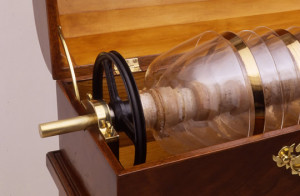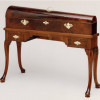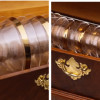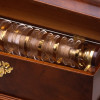- Other Forms
- Armonica
Armonica
Member Gallery
Address
Contact
This musical instrument is a reproduction of the case and stand for Benjamin Franklin's glass armonica. It is designed to house a Model F29 glass armonica with thirty-six glasses that was made by the late Gerhard Finkenbeiner. Franklin's instrument is located at the Franklin Institute and Science Museum in Philadelphia. It used foot power to rotate the glasses with the motion governed by a heavy flywheel. Finkenbeiner's is powered by a small electric motor with a rheostat controlling the speed of the rotating cups. The spindle to which the glasses are affixed in Franklin's instrument turn on brass gudgeons or collars at each end. Finkenbeiner's spindle turns on two stainless steel ball bearing assemblies.
The case is made of white oak and is 11" wide at the left end and 5" wide at the right end to accommodate the different sized glasses. The lid is made of spruce and incorporates eight tapered staves that are coopered as in the original. The body of the stand is made of fir and the legs are solid mahogany. A 3/4" brass shaft was used for the spindle and it protrudes from the left end of the cabinet about 2 inches. Here, on the original, Franklin attached his flywheel, which he describes "of mahogany, 18 inches diameter, and pretty thick, so as to conceal near its circumference about 25 lb. of lead." The flywheel on the original armonica is missing and was not made for the reproduction.
I designed the case to hide the motor and rheostat within the stand behind shortened drawers. Both drawers are functional (the left one in the original is a fake) and are made of oak. They are lined with epoxy to hold water for the convenience of the player. The left drawer is 3" deep and hides the motor. The right drawer is 1 1/4" deep and hides the rheostat. The wiring that connects the rheostat and motor runs in a covered groove in the undersurface of the top of the stand.
The case brasses were designed from photographs of the originals. Brass covers were designed and constructed to house the ball bearing assemblies and simulate the original brass gudgeons. They were fabricated in such a way as to allow for the removal of the spindle and glasses for adjustment. The case and stand are finished with shellac and wax. To prevent damage from water dripping from the glasses, I finished the sides and bottom of the interior of the case with water based satin polyurethane and acrylic finish after first applying dark shellac to obtain the proper color.
In describing his armonica, Franklin wrote, "its tones are incomparably sweet beyond those of any other. I calligraphed these words on the right spindle support.
WOODS: Oak, fir, spruce, mahogany, mahogany veneer
PHOTOGRAPH: Dirk Bakker.
PROVENANCE: 1996 "THE ARMONICA CABINET," Glass Music World 11, no. 1:3-4, (winter 1996).
1997 GLASS MUSIC INTERNATIONAL MUSIC FESTIVAL, Massachusetts Historical Society, Boston, MA, April 25, 1997. Performance on Lash armonica by Thomas Bloch, Paris, France.
1998 "THE ART OF SCIENCE," Scientific American Frontiers with Alan Alda, Public Television, Feb 18, 1998 {Filmed at Gerhard Finkenbeiner, Inc. with Thomas Bloch playing Lash armonica).
1998 "BEN FRANKLIN'S ARMONICA FAITHFULLY REPRODUCED," Fine Woodworking, Notes and Comments, 130:26, June 1998.
2000 "BENJAMIN FRANKLIN'S ARMONICA," Franklin Gazette, Vol. 10, No. 2, summer 2000.
2000 PHILADELPHIA MUSEUM OF ART, - Glass Armonica Concert, Thomas Bloch playing Lash armonica, Van Pelt Auditorium, April
2001 "REPRODUCING BENJAMIN FRANKLIN'S ARMONICA," American Period Furniture, Vol. 1, 2001.





